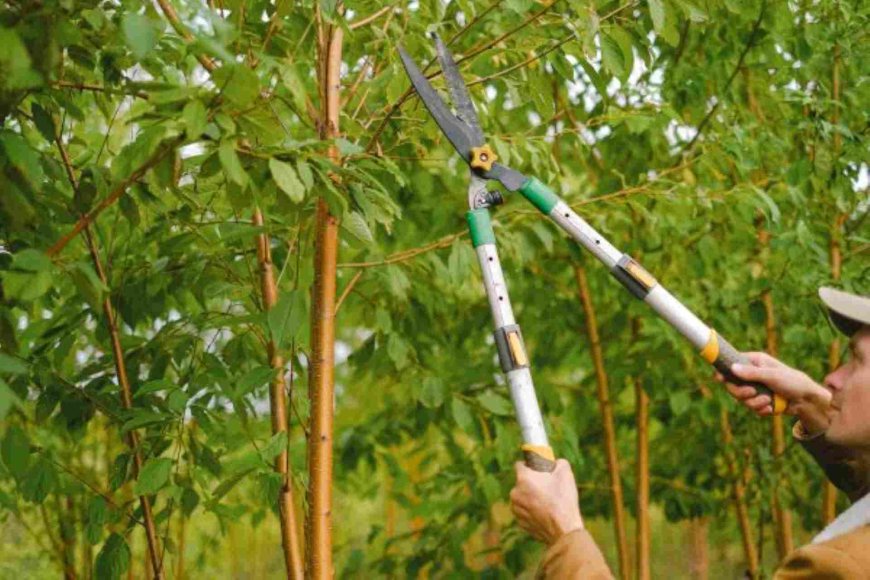Tree Pruning – A Complete Guide to Healthy, Beautiful Trees
Tree pruning might seem like just a landscaping chore, but it’s a vital part of tree care. It keeps your trees healthy, safe, and stunning. Whether you're doing a light trim or hiring an arborist for a big job, a little effort goes a long way toward maintaining your property’s beauty and safety.

Think of your trees like hair. Sometimes they need a trim to look their best, stay healthy, and grow strong. Thats exactly what tree pruning does. Its more than just cutting off a few branches its a strategic, skillful process that keeps your trees happy and your yard safe.
What is Tree Pruning?
Tree pruning is the selective removal of specific branches to improve a trees health, structure, and appearance. Its part art, part science and when done right, it pays off big time.
Why Tree Pruning Matters
-
Keeps trees structurally sound
-
Prevents dead branches from falling
-
Encourages new growth
-
Makes your property look polished and well cared for
Types of Tree Pruning
Different trees and situations require different pruning methods. Heres a breakdown:
Crown Cleaning
Removing dead, diseased, or broken branches from the crown of the tree. This is the most common and safest type of pruning.
Crown Thinning
Selective removal of branches to increase light penetration and air circulation throughout the crown. This helps reduce wind resistance and prevents storm damage.
Crown Raising
Removing lower branches to clear pathways, sidewalks, or views. It's often done for clearance over roads or buildings.
Crown Reduction
Reducing the overall size of the tree canopy. Ideal for preventing trees from interfering with power lines or structures.
Deadwooding
Exactly what it sounds like removing dead limbs to improve safety and health.
Benefits of Tree Pruning
Enhances Tree Health
Removing diseased or insect-infested limbs can prevent problems from spreading to other parts of the tree or even nearby trees.
Improves Aesthetics
A well-pruned tree looks neat, balanced, and beautiful. It boosts your home's curb appeal instantly.
Prevents Property Damage
Branches too close to your home, roof, or utility lines can cause expensive issues during storms or high winds.
Encourages Fruit and Flower Production
Pruning can stimulate more abundant and higher-quality blooms or fruits by letting in more sunlight and focusing energy where it matters.
When to Prune Trees
Seasonal Guidelines
-
Winter (Dormant Season): Best time for most trees. Encourages vigorous growth in spring.
-
Spring: Good for corrective pruning.
-
Summer: Used to slow down growth or remove heavy limbs.
-
Fall: Generally not recommended trees are preparing for dormancy.
Signs Your Tree Needs Pruning
-
Dead or dying branches
-
Misshapen growth
-
Tree looks too dense
-
Branches are scraping against your house
-
Signs of disease or infestation
Tools Used in Tree Pruning
You cant prune well without the right gear:
Hand Pruners
Perfect for small twigs and branches under inch thick.
Loppers
Like pruners, but with long handles for extra leverage great for medium-sized branches.
Pruning Saws
Curved or straight blades designed to cut larger limbs (over 1 inches thick).
Pole Pruners
Extendable tools that let you reach high branches from the ground.
DIY Tree Pruning Tips
Safety First
-
Wear gloves, goggles, and a helmet if working overhead.
-
Dont prune near power lines call the pros.
Proper Cutting Techniques
-
Cut just outside the branch collar (the swollen area where the branch meets the trunk).
-
Avoid leaving stubs or cutting too flush.
-
Use the three-cut method for large limbs to prevent bark tearing.
What to Avoid
-
Dont remove more than 25% of a trees crown at once.
-
Avoid "topping" trees it can kill them.
-
Dont prune during pest season unless absolutely necessary.
Professional Tree Pruning Services
When to Hire a Pro
-
If the branches are high or thick
-
If the tree is near power lines
-
If youre unsure how much to cut
What to Expect
A reputable arborist will:
-
Assess the trees health and structure
-
Use proper pruning techniques
-
Clean up debris and offer maintenance advice
Common Tree Pruning Mistakes
Topping Trees
This is when people cut the top off a tree to reduce its size. It leaves the tree weak and prone to disease.
Over-Pruning
Taking off too much at once shocks the tree and may kill it.
Improper Timing
Pruning at the wrong time can attract pests or cause unnecessary stress to the tree.
Tree Pruning Costs
Average Price Ranges
-
Small trees: $75$300
-
Medium trees: $150$500
-
Large trees: $500$1000+
Factors That Affect Cost
-
Tree size and species
-
Number of branches being pruned
-
Location and accessibility
-
Urgency (emergency pruning costs more)
Environmental Impact of Pruning
Promotes Sustainability
Pruning encourages strong growth and extends the life of your trees reducing the need for replacements.
Protects Wildlife and Nearby Plants
Proper pruning keeps habitats intact and prevents falling limbs from damaging nearby landscaping.
Conclusion
Tree pruning might seem like just a landscaping chore, but its a vital part of tree care. It keeps your trees healthy, safe, and stunning. Whether you're doing a light trim or hiring an arborist for a big job, a little effort goes a long way toward maintaining your propertys beauty and safety.
FAQs
1. How often should trees be pruned?
Every 13 years, depending on the tree species and condition.
2. Is pruning trees in summer okay?
Yes, especially to slow growth or remove heavy limbs but avoid major pruning during extreme heat.
3. Can pruning kill a tree?
Yes, if done improperly or excessively. Avoid topping and over-pruning.
4. Should I seal pruning cuts?
Usually not. Trees naturally heal; sealing can trap moisture and cause decay.
5. Whats the best time to prune flowering trees?
Right after they bloom so you dont cut off next years buds.
































